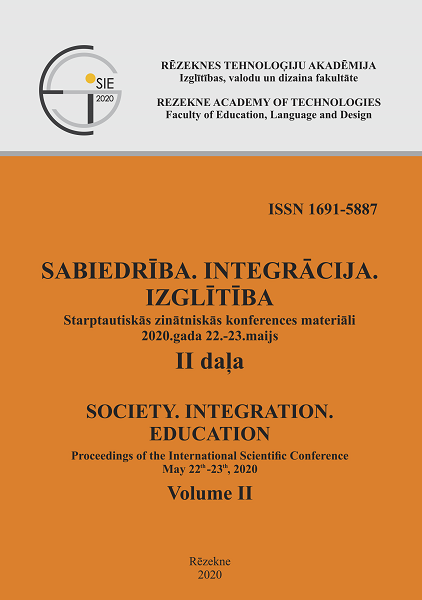ETHNIC IDENTITY AND ETHNIC CULTURE AMONG THE RESIDENTS OF EASTERN LATVIA
DOI:
https://doi.org/10.17770/sie2020vol2.4886Keywords:
ethnic identity, ethnic culture, ethnic character, Eastern LatviaAbstract
Ethnic identity is an important component of a person’s personal identity. Many studies indicate that a strong and secure ethnic identity positively correlates with an adequate self-esteem, coping mechanisms, and optimism. In this study the authors intend to analyse the socio-psychological theories of the ethnic group, ethnic identity and the relationship of ethnic identity and ethnic culture. This article reflects findings gained as a result of a comparative analysis of the characteristics of ethnic identity and its connectedness with ethnic culture among the students of Eastern Latvia. The authors identify what is common for the ethnic groups of the region, as well as point to the differences in the perceptions of their ethnic identity and its manifestation among the respondents. Research methodology: The authors developed a methodology that combines quantitative and qualitative methods of processing the results. This article reflects part of the data obtained as a result of conducting inquiry, where respondents were asked to name literary works in which their ethnic character is reflected most vividly, as well as to name traditions that corresponds to their ethnic identity. The results of the study suggest that there is an idea of the ideal ethnic character and its manifestation. The ethnic traditions, mentioned by the respondents who has Latvian as their native language, were associated with nature, cyclical rhythms in nature and religious symbols. As for the respondents who had Russian as their mother tongue, the most significant were such public holidays such as the New Year, as well as traditional religious festivals.Downloads
References
Albert, R., Schneeweis, A, & Knobbe, I. (2005). Strengthening, hiding or relinquishing ethnic identity in response to threat: Implications for intercultural relations. Intercultural Communication Studies, 24(1), 107-118.
Berking, H. (2003). „Ethnicity is everywhere”: On globalization and the transformation of cultural identity, Current Sociology, 51(3), 248-264.
Berry, J.W. (1980). Acculturation as varieties of adaptation In A. Padilla (Eds.). Acculturation: Theory, Models and Some New Findings. (pp.9-25). Boulder: Westview Press.
Blanton, R. (2015). Theories of Ethnicity and the Dynamics of Ethnic Change in Multiethnic Societies. Retrieved from https://doi.org/10.1073/pnas.1421406112
Blaumanis, R. (1994). Purva bridējs. In Blaumanis, R. & Kalniņa, I.(Ed.), Kopoti Raksti (pp.353–393). Rīga: Jumava.
Brigadere, A. (1998). Sprīdītis. Rīga: Zvaigzne.
Cabrera, N., (2013). Positive Development of Minority Children. Social Policy Report,27(2). Retrieved from: https://www.srcd.org/sites/default/files/file-attachments/spr_272_final.pdf
Cuellar, I., Harris, L.C., & Jasso, R. (1980). An acculturation scale for Mexican American normal and clinical populations. Hispanic Journal of Behavioural Sciences, 2(3), 199-217.
Gamsakhurdia, V. (2017). Quest for ethnic identity in the modern world - the Georgian case. Cogent Social Sciences, 2(1). DOI: https://doi.org/10.1080/23311886.2017.1309735.
Goncharov, A. (1915). Oblomov. London: George Allen & UNWIN, Ltd.
Grīns, A. (2016). Dvēseļu Putenis. Rīga: Domas spēks.
Hjort, H. (2004). Ethnic Identity and Reconciliation: Two Main Tasks For the Young in Bosnia Herzegovina. Göteborg: Göteborg University.
Holondovich, E.N. (2015). Russkij harakter v rabotah F.M. Dostoevskogo. Moskva: Izd-vo «Institut psihologii RAN».
Jensen, L.A., Arnett, J.J., & McKenzie, J. (2011). Globalization and cultural identity developments in adolescence and emerging adulthood. In S. J. Schwartz, K. Luyckx, & V. L. Vignoles (Eds.), Handbook of Identity Theory and Research (pp.285- 301).
Kaudzītes, R. & Kaudzītes, M. (2014). Mērnieku laiki. Rīga: Zvaigzne ABC.
Lāms, O. (1993). Latviešu Eposs: Cilme un Funkcionalitāte. Disertācijas kopsavilkums filoloģijas doktora grāda iegūšanai. Rīga, LU.
Makarevičs, V. (2017). Dzimtenes tēls Raiņa daiļradē. In M. Burima (Ed.). Aspazija-Rainis. Dzīvā dzīve. Kolektīvā Monogrāfija (pp.134 - 143). Rīga: Zinātne.
Marcia, J. (1980). Identity in adolescence. In J. Adelson (Ed.), Handbook of Adolescent Psychology (pp.159-187).
Nash, R. (2005). The economy of birth-rates in the Czech Republic. In C. B. Douglas (Eds.), Barren States: The Population “Implosion” in Europe. (pp. 93-113). New York: Berg.
Phinney, J.S. (1990). Ethnic identity in adolescents and adults. Psychological Bulletin by the American Psychological Association, 108(3), 499-514.
Phinney, J.S. & Ong, A.D. (2007) Conceptualization and measurement of ethnic identity: Current status and future directions. Journal of Counselling Psychology, 54(3), 271–281.
Pumpurs, A. (1988). Lāčplēsis: Latvju Tautas Varonis. Tautas Eposs. Rīga: Zinātne.
Pushkin, A.S. (1960). Skazka o rybake i rybke. Moskva. Sovetskaja Rossija.
Rotheram, M.J. & Phinney, J.S. (1986). Introduction: Definitions and perspectives in the study of children’s ethnic socialization. In Phinney, J.S. & Rotheram, M.J. (Eds.), Children’s Ethnic Socialization: Pluralism and Development. (pp.10-28). Beverly Hills: Sage Publications.
Russkij nacional'nyj harakter v proizvedenii L. N. Tolstogo "Vojna i mir”. (2019). Retrieved from www.allsoch.ru/sochineniya/7758
Samalavičius, A. (2005). National Identity, Culture and Globalization Lithuania Wakes up to a New Social and Cultural Reality. Retrieved from: https://www.eurozine.com/national-identity-culture-and-globalisation/
Segers, R.T. (2008). A New Japan for the Twenty-First Century. An Inside Overview of Current Fundamental Changes and Problems. Routledge: London, New York.
Sodowsky, G.R. & Plake, B. (1992). A study of acculturation differences among international people and suggestions for sensitivity to within-group differences. Journal of Counselling and Development, 71, 53-59.
Swenson, R.R. & Prelow, H.M. (2005). Ethnic identity, self-esteem, and perceived efficacy to psychosocial outcomes among urban adolescents. Journal of Adolescence, 28, 465-477.
Turner, J.C. (2004). Fluidity in the self-concept: The shift from personal to social identity. European Journal of Social Psychology 34(3):257 – 278.
Witherspoon, D. (2013). Positive development of minority children. Social Policy Report, 27(2), 3-22.
Wright, J.D. (2015). (2nd Ed.). International Encyclopedia of the Social & Behavioral Sciences. USA: University of Central Florida, Orlando.


